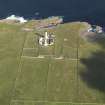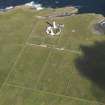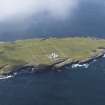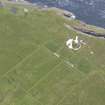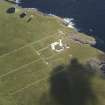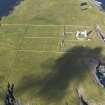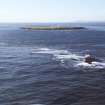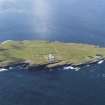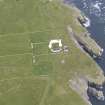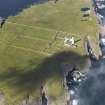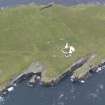Muckle Skerry, Lighthouses And Keepers' Cottages
Lighthouse(S) (18th Century), Lighthouse(S) (19th Century), Lighthouse Keepers House(S) (18th Century)
Site Name Muckle Skerry, Lighthouses And Keepers' Cottages
Classification Lighthouse(S) (18th Century), Lighthouse(S) (19th Century), Lighthouse Keepers House(S) (18th Century)
Alternative Name(s) Pentland Firth; Pentland Skerries Ii
Canmore ID 9500
Site Number ND47NE 11
NGR ND 46496 78415
Datum OSGB36 - NGR
Permalink http://canmore.org.uk/site/9500
- Council Orkney Islands
- Parish South Ronaldsay
- Former Region Orkney Islands Area
- Former District Orkney
- Former County Orkney
ND47NE 11.00 46496 78415
ND47NE 11.01 ND 46480 78397 Keepers Cottage 1
ND47NE 11.02 ND 46518 78400 Keepers Cottage 2
ND47NE 11.03 ND c. 4649 7841 Old Lighthouse
ND47NE 11.04 ND c. 46563 78468 Rocket Staff
Lighthouse [NAT]
OS 1:10,000 map, 1971.
(Location cited as ND 465 783). Muckle Skerry, Pentland Skerries lighthouses, completed 1833 by engineers Thomas Smith and Robert Stevenson. Two towers replacing the original lighthouses of 1794. Of similar construction but differing heights, both are tapering circular-section structures with corbelled walkways. The shorter one rises from a circular one-storey building, and has carried a foghorn since 1909. There are single-storey keepers' cottages.
J R Hume 1977.
Double lights 80 and 60ft high respectively and 60ft apart were built on the Muckle Skerry by Orkney masons supervised by Robert Stevenson as his first major work for the Northern Lighthouse Board. Revolving lights were not provided although Stevenson asked for this (Munro 1979, 59, 64).
The station was rebuilt, along with others, between 1821 and 1830 in a 'more permanent' form and accord with the Commissioners' 'national establishment' policy. A dioptric or catadioptric light was fitted in 1848, and the burning of mineral oil (paraffin) introduced (initially on a trial basis) in 1870. The double light was discontinued in 1895 on the installation of powerful group-flashing lights. Improved accommodation was provided in recent years and the light was electrified (maximum candlepower 710,000) in 1958.
The rock station was attacked by aerial bombing in 1941 and the wife and seven children of the Principal Keeper were buried nearby after their death from diptheria in 1877.
[For photograph of the twin towers, see Munro 1979, 212].
R W Munro 1979.
The heights of the original two towers are cited as 116ft (the more northerly) and 94ft 6ins respectively. They were first lit on 1 October 1794.
K Allardyce and E M Hood 1986.
Name: Pentland Skerries II (1833)
Location: N58 41 W2 55 Pentland Firth, 5 miles NE of Duncansby Head
Designed and built: Robert Stevenson
Light first exhibited: 1833
Description: taller of two original stone towers, now painted white
Height of light above MHW: 171ft (52m)
Height of tower: 118ft (36m)
Light source and characteristics: W Gp Fl (1) ev 30 secs. 250W metal halide lamp: 710,000 cp: 25nm nominal range
Fog warning apparatus: siren (1) ev 45 secs
Manning: unwatched (automatic since 31 March 1994), monitored from Northern Lighthouse Board HQ, Edinburgh
Rebuilt from the taller of two original towers with improved optical apparatus. Listed
C Nicholson 1995.
This lighthouse has been automated.
Information from RCAHMS (RJCM), 18 May 2000.
This lighthouse guards the E entrance to the Pentland Firth, being built on the Pentland Skerries, a group of islands placed situated roughly central to the 'Hell's Mouth'.
In 1794, Thomas Smith and Robert Stevenson built two lighthouses on the island. Built to heights of 59ft [18m] and 79ft [24.1m] respectively, their optics contained 66 reflectors in both cases. In the 1820's, both towers were rebuilt in more permanent form. Stone from Herston was used to increase the height of the higher tower to over 100ft [30.5m]. The optics were changed to refracting lenses in 1847 for increased efficiency. The lower light was discontinued in 1895, but a foghorn was mounted on the tower. The lighthouse was automated in 1994.
S Krauskopf 2003.
Note (18 May 2000)
This lighthouse has been automated.
Information from RCAHMS (RJCM), 18 May 2000.
Publication Account (2007)
Pentland Skerries Lighthouses
(Institute Civil Engineers Historic Engineering Works no. HEW 1985)
The lighthouses of Orkney represent an important civil engineering contribution to the island and maritime safety. The most historic is the 70 ft tall North Ronaldsay Lighthouse built by the Northern Lighthouse Board in 1789, using local stone and workmen from Leith, only three years after the Board was founded. This lighthouse was closely followed by Pentland Skerries in 1794 to the south at the eastern entrance to the hazardous Pentland Firth. The engineer for both lighthouses was Thomas Smith, who developed, made and installed arrays of facetted mirror-glass parabolic reflector oil lamps.
At Pentland Skerries, Smith directed the erection of two circular masonry towers, 60 ft and 80 ft high, and installed 66 reflector lamps in total. The towers were sited 60 ft apart as a distinction to mariners. In the 1820s they were rebuilt under Robert Stevenson’s direction in local stone 100 ft apart, the taller being 118 ft high. In 1848 lenses were introduced. The lower light was discontinued in 1895 on the introduction of group flashing lights. The light was converted to electrical operation in 1939.
R Paxton and J Shipway, 2007.
Reproduced from 'Civil Engineering heritage: Scotland - Highlands and Islands' with kind permission from Thomas Telford Publishers.
Orkney Smr Note
First lit on 1 October 1794: two towers, one 80ft high the
other 60ft, to distinguish from other lights. Heightening of the
towers by rebuilding on the same site but now 100ft apart, the
higher tower now 118ft high, was apparently completed 1833.
Dioptric lamps fitted 1848. In 1895 the low light was
discontinued, as the two lights were too readily mistaken for
ships' masthead lights, and from 1909 the low tower was used as a
platform for a fog signal. [R1]
Information from Orkney SMR [n.d.]





















